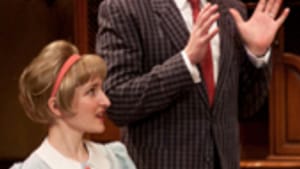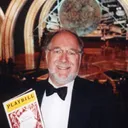Stay in the Loop
BSR publishes on a weekly schedule, with an email newsletter every Wednesday and Thursday morning. There’s no paywall, and subscribing is always free.
Black and white, then and now
"Clybourne Park' at the Arden (1st review)

Each act of Clybourne Park begins with chatter about place names and the connection between cities and countries. (What's the capital of Morocco or the derivation of the word "Neapolitan"?) What seems, at first, like small talk becomes a theme in this excellent new drama.
Playwright Bruce Norris sneaks unobtrusively from these conversations into a conflict that concerns racially changing neighborhoods— and, in a larger sense, territorial rights.
Be forewarned about two misconceptions you might draw from the buzz about this play, which won the 2011 Pulitzer Prize for drama. Don't come to Clybourne Park expecting comedy. This is genuine drama, with laughs as a bonus; let them creep up on you. In this regard, Clybourne Park resembles Tracy Letts's August, Osage County and Superior Donuts.
Second, you don't need any familiarity with Lorraine Hansberry's Raisin in the Sun. The original producer said that the new play was "loosely inspired by" A Raisin in the Sun. But Clybourne Park stands on its own. If you do recognize that this is Raisin's same neighborhood, it adds an extra layer of appreciation, but it's not a prerequisite.
Familiar neighborhood
A neighbor, Karl, is based on Karl Lindner, a white character from A Raisin in the Sun who attempted to bribe a black family into abandoning their plans to move in. What the two plays have in common is aspirations for a better life and a specific concern about property ownership. (In real life, Hansberry's parents bought a house in a white neighborhood of Chicago in the 1950s.)
Yes, the property is one of the most famous houses in 20th-Century drama, and the original home is historically preserved here. But I sat next to a person who didn't remember the original and yet enjoyed Clybourne Park tremendously.
Norris, in a sense, looked at Hansberry's story and turned it around, telling it from the perspective of whites who wanted to keep the blacks out. Then he looked at how black families 50 years later might react to white intruders.
Talking like real people
Norris's writing is abrasively provocative, and has many similarities to Tracy Letts: People talking like real people, often in overlapping conversations. (Letts and Norris both are based at Chicago's Steppenwolf Theatre, as was the Arden's director, Edward Sobel.) But Norris's style is more discursive.
Both acts of Clybourne Park take place in a modest home in northwest Chicago. The first, set in 1959, involves a middle-class white family, their black maid, a pastor and a visitor from the neighborhood association who wants to prevent a "colored family" from buying the house.
The second act takes place 50 years later at the same home. The neighborhood has turned from white to black, and now a white couple has purchased the house, only to encounter resistance from a black couple who represent the community.
It's a bit of a distraction that the white family wants to make major architectural changes to the property— which, naturally, would provoke the neighbors' concern. But Norris soon brings us back to the major topic: that people tend to band together into groups, ethnic or otherwise, to resist change.
Versatile actors
Like Superior Donuts, this play contains local references that have special resonance for people (like my wife) who grew up in Chicago. But it could easily be set in many other Northern cities. And the patronizing attitude of the white woman to her maid is an interesting counterpoint to the white Alabamans in The Scottsboro Boys.
Each act has seven distinct characters, well fleshed out and beautifully acted by David Ingram, Julia Gibson, Erika Rose, Steve Pacek, Josh Tower, Ian Merrill Peakes and Maggie Lakis. They're extraordinarily versatile actors in the way they make major differentiations between their roles in each act. The direction by Edward Sobel is spot on, sets and costumes by James Kronzer and Rosemarie McKelvey are apt and the sound by Jorge Cousineau— involving transistor radios in 1959 and cell phones in 2009— is impeccable.
An attorney in the second act turns every part of every conversation toward herself. Her self-absorption evokes laughs as it spotlights the fact that most of the players are involved in their own worlds.
The biggest laugh of the night comes when we hear the answer to the riddle: "How is a white woman like a tampon?" (Good taste precludes me from quoting it here.) The darkest joke, however, is that for all the apparent strides in race relations over he past half century, people still have a contentious time dealing with their differences.♦
To read another review by Alaina Mabaso, click here.
To read a follow-up by Steve Cohen, click here.
Playwright Bruce Norris sneaks unobtrusively from these conversations into a conflict that concerns racially changing neighborhoods— and, in a larger sense, territorial rights.
Be forewarned about two misconceptions you might draw from the buzz about this play, which won the 2011 Pulitzer Prize for drama. Don't come to Clybourne Park expecting comedy. This is genuine drama, with laughs as a bonus; let them creep up on you. In this regard, Clybourne Park resembles Tracy Letts's August, Osage County and Superior Donuts.
Second, you don't need any familiarity with Lorraine Hansberry's Raisin in the Sun. The original producer said that the new play was "loosely inspired by" A Raisin in the Sun. But Clybourne Park stands on its own. If you do recognize that this is Raisin's same neighborhood, it adds an extra layer of appreciation, but it's not a prerequisite.
Familiar neighborhood
A neighbor, Karl, is based on Karl Lindner, a white character from A Raisin in the Sun who attempted to bribe a black family into abandoning their plans to move in. What the two plays have in common is aspirations for a better life and a specific concern about property ownership. (In real life, Hansberry's parents bought a house in a white neighborhood of Chicago in the 1950s.)
Yes, the property is one of the most famous houses in 20th-Century drama, and the original home is historically preserved here. But I sat next to a person who didn't remember the original and yet enjoyed Clybourne Park tremendously.
Norris, in a sense, looked at Hansberry's story and turned it around, telling it from the perspective of whites who wanted to keep the blacks out. Then he looked at how black families 50 years later might react to white intruders.
Talking like real people
Norris's writing is abrasively provocative, and has many similarities to Tracy Letts: People talking like real people, often in overlapping conversations. (Letts and Norris both are based at Chicago's Steppenwolf Theatre, as was the Arden's director, Edward Sobel.) But Norris's style is more discursive.
Both acts of Clybourne Park take place in a modest home in northwest Chicago. The first, set in 1959, involves a middle-class white family, their black maid, a pastor and a visitor from the neighborhood association who wants to prevent a "colored family" from buying the house.
The second act takes place 50 years later at the same home. The neighborhood has turned from white to black, and now a white couple has purchased the house, only to encounter resistance from a black couple who represent the community.
It's a bit of a distraction that the white family wants to make major architectural changes to the property— which, naturally, would provoke the neighbors' concern. But Norris soon brings us back to the major topic: that people tend to band together into groups, ethnic or otherwise, to resist change.
Versatile actors
Like Superior Donuts, this play contains local references that have special resonance for people (like my wife) who grew up in Chicago. But it could easily be set in many other Northern cities. And the patronizing attitude of the white woman to her maid is an interesting counterpoint to the white Alabamans in The Scottsboro Boys.
Each act has seven distinct characters, well fleshed out and beautifully acted by David Ingram, Julia Gibson, Erika Rose, Steve Pacek, Josh Tower, Ian Merrill Peakes and Maggie Lakis. They're extraordinarily versatile actors in the way they make major differentiations between their roles in each act. The direction by Edward Sobel is spot on, sets and costumes by James Kronzer and Rosemarie McKelvey are apt and the sound by Jorge Cousineau— involving transistor radios in 1959 and cell phones in 2009— is impeccable.
An attorney in the second act turns every part of every conversation toward herself. Her self-absorption evokes laughs as it spotlights the fact that most of the players are involved in their own worlds.
The biggest laugh of the night comes when we hear the answer to the riddle: "How is a white woman like a tampon?" (Good taste precludes me from quoting it here.) The darkest joke, however, is that for all the apparent strides in race relations over he past half century, people still have a contentious time dealing with their differences.♦
To read another review by Alaina Mabaso, click here.
To read a follow-up by Steve Cohen, click here.
What, When, Where
Clybourne Park. By Bruce Norris; Edward Sobel directed. Through March 25, 2012 on the Arcadia stage, Arden Theatre, 40 N. Second St. (215) 922-8900 or www.ardentheatre.org.
Sign up for our newsletter
All of the week's new articles, all in one place. Sign up for the free weekly BSR newsletters, and don't miss a conversation.

 Steve Cohen
Steve Cohen